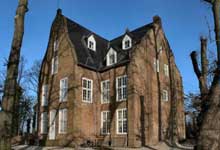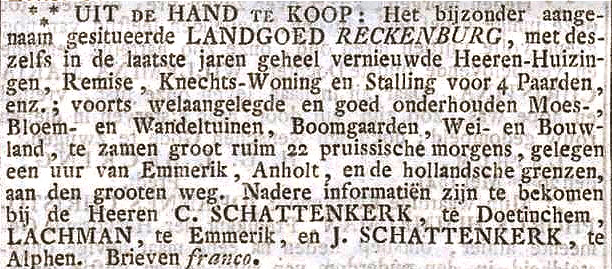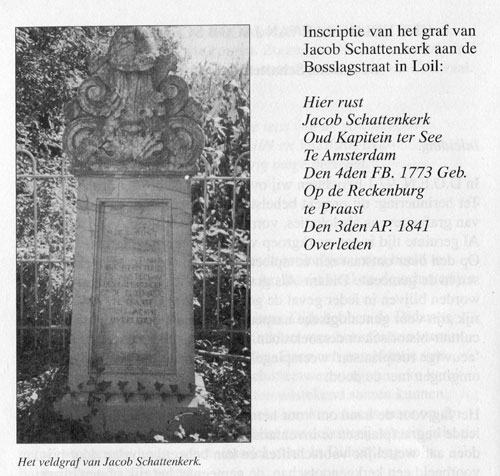Jacob Schattenkerk
Jacob who was born in 1773 in Amsterdam as son of the German timber merchant Johan George Schattenkerk and Wendelina Eeftinck married in 1805 in Zwammerdam with Maria Cornelia Belly (1772 Demerara- 1845 Zwammerdam)
Fragments of the life of Jacob Schattenkerk retrieved from various archives:
His mother died when he was 8 years old. He must have heard from her of her brother Willem Eeftinck who had left for Demerary (now Guyana near Suriname) . It may have started his longing for adventure. When he was 15 years old he started training as a sailor at the VOC ( Dutch East Indies Company). In May 1788 he was accepted as a sea cadet (Cadet de Marine) / helmsman's apprentice on the ship Zeepaard to Batavia (now Jakarta), after which he probably returned to Amsterdam as a passenger. In November 1790 he sailed as a junior sea officer (Sous lieutenant) with the ship De Meerwijk again to Batavia and returned in the same position on the ship De Verwachting with which he arrived on the island of Texel off the coast of Northern Holland in February 1794 with destination Amsterdam. More information about him cannot be found in the VOC archives. But he did go back to Batavia because in October 1796 he returned from there on the ship De Grayloud.

adv. De Oprechte Haarlemmer Courant
Was that the end of his career as a naval officer ?
Possibly not. The descendants of eldest son Charles were told that in the period after the French invasion in 1795 he was active in hijacking English ships. At the time, the then French/Dutch government gave permission in 1796 for what is called privateering. Reason: France was at war with England and they hijacked Dutch ships, close to our coast. Privateering by the Dutch ended around 1804 when the English navy became too strong. Evidence for this family story is difficult to find in the archives because they are incomplete, some are in Holland, including the Dutch National Archives (N.A.), and some in France. But they are not fully indexed. A confirmation at least of the story that he sailed after 1796 is that a grandson who re-buried him in 1897 in his estate has named him on his memorial Old Sea Captain. Is that a fantasy based on his short experience as a naval officer at the VOC, or did he still sail after 1896, promoted to captain and perhaps involved in privateering ? It is not totally out of the question, but there is still archival work to be done to prove it.!
After returning from his travels, he will certainly have visited his uncle Willem Eeftinck, brother of his deceased mother, who now lived in his estate Buitendorp in Zwammerdam since 1795 to get acquainted and to exchange stories.
His father died in 1802 and uncle Willem later the same year. If he was in the country that year or else later he would have visited his aunt Eeftinck-Blondel and offered his help. In the house of uncle and aunt he would have met his future wife Maria Belly adopted daughter of Maria Catharina Blondel (circa 1758-1815) a sister of his aunt and Charles Desbarats (circa 1741-1808).
They married in 1805. In May that year, a month after his marriage, Jacob advertised in the Rotterdamsche Courant as a boarding school holder in Buitendorp. I do not know if anything has come of it.
 In February 1806 their first son Charles was born .
In August of that year, his nephew Jean Charles Philippe Eeftinck died at the age of 18. He was the only child of the widow Eeftinck-Blondel . Jacob in memory of him his second son born in July 1807 after his nephew Jean Charles Philippe Eeftinck. As first names, that is. As using a surname as first name is not common in Holland that changed in subsequent generations to the double surname Eeftinck-Schattenkerk which is the surname of my grant-grandmother from mother side .
In 1807 Jacob bought a house (# 37) on the Rhine to the east of a shipyard and to the west of the country estate Withenlust, which is now the Molenstraat in Zwammerdam.
In the same year he bought another house with a garden house (# 41) located on the Rhine within Zwammerdam from Abraham Tim.
At the end of 1811, Jacob was appointed deputy mayor of Zwammerdam.
In February 1806 their first son Charles was born .
In August of that year, his nephew Jean Charles Philippe Eeftinck died at the age of 18. He was the only child of the widow Eeftinck-Blondel . Jacob in memory of him his second son born in July 1807 after his nephew Jean Charles Philippe Eeftinck. As first names, that is. As using a surname as first name is not common in Holland that changed in subsequent generations to the double surname Eeftinck-Schattenkerk which is the surname of my grant-grandmother from mother side .
In 1807 Jacob bought a house (# 37) on the Rhine to the east of a shipyard and to the west of the country estate Withenlust, which is now the Molenstraat in Zwammerdam.
In the same year he bought another house with a garden house (# 41) located on the Rhine within Zwammerdam from Abraham Tim.
At the end of 1811, Jacob was appointed deputy mayor of Zwammerdam.
Staatkundig dagblad van het Departement
der Zuiderzee 08-12-1811
|
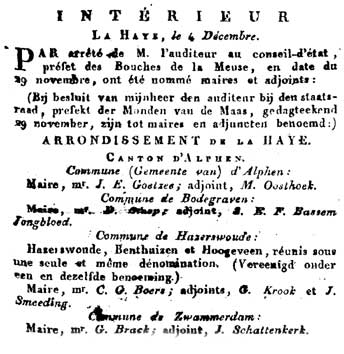 |
In 1814, Jacob was was appointed general estate manager by his aunt, the widow Eeftinck - Blondel. Shortly afterwards he tried to manage the affairs of the Eeftinck plantation, Blijgezicht in Demerary by appointing a local management team..
In 1815, after the death of the widow Desbarats-Blondel, the adoptive mother of his wife, Jacob became executor of her will together with the Amsterdam merchant Jacques Marc Fraissinet, experienced in business with Demerary.
Subsequently, after the death of his aunt Eeftinck-Blondel in December 1816, her considerable inheritance was in principle divided between Jacob and Barendina Eeftinck, sister of Willem Eeftinck, and here too Jacob was appointed executor of the will and, Jacob and his wife receive her share in the estate of the widow Desbarats.
In 1816 Jacob sacked the management team of the Blijgezicht plantation from 1814 and appointed a new team..
in June 1817, he orders notary Brack to sell the house (# 41) that he bought in 1807. At the end of October 1817 he sold it to Mr. Sierman.
In September 1817 he buys a house called Bouwlust in Aarlanderveen with a considerable amount of land and the other half of the house of Buitendorp (# 64) from co-heir aunt Barendina Eeftinck
in June 1817 he orders notary Brack to sell the house (# 41) which he bought in 1807. At the end of October 1817 he sold it to Mr. Sierman.
In September 1817 he buys a house in Aarlanderveen with a considerable amount of land and the other half of the house of Buitendorp (# 64) from co-heir aunt Barendina Eeftinck
In 1818 the Blijgezicht plantation was sold by the new management team /li>
In 1819 he bought two houses called Catharina's-lust with a considerable amount of land, everything up to the Rhine in the Steekterpolder, from Baron van Rheede.
In 1820 he appoints an agent to collect interest on a mortgage (or mortgages) from a plantation in Demerary belonging to the estate of the widow Desbarats. See here..
The census of 1826-27 confirms that Jacob still lives at Buitendorp (# 64). He also owns the nearby properties (# 62) which he leases to a shopkeeper and (# 63) to a gardener. His neighbor at (# 65) is builder Leendert Kwakernaak the future father of his dsughter in laww.
|
In 1828 Jacob bought the then derelict country estate With en Lust (Withenlust), built at the beginning of the eighteenth century, including the accompanying estate from the Aalburg / Keijzer owners since 1817. On either side stood two wood saw mills De Akerboom (to the east) and De Palmboom (the West ). He replaces it with a much simpler home (see right). In 1867 it was sold by the then owner to the "Association of Christian Interests" under the chairmanship of his grandson Jacob Eeftinck Schattenkerk. That house had presently also been demolished. It stood east of the current Reformed Church on Molenstraat, built in 1905. The remains of the renowned garden of the original Withenlust estate with its famous waterways on the right side of the national road can still be seen. The mills were demolished between 1922 and 1927.
|
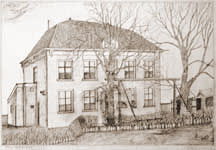 |
Image: Advertisement from the Dagblad van 's Gravenhage 5 March 1828 with a romantically colored drawing from the end of the Eighteenth Century.

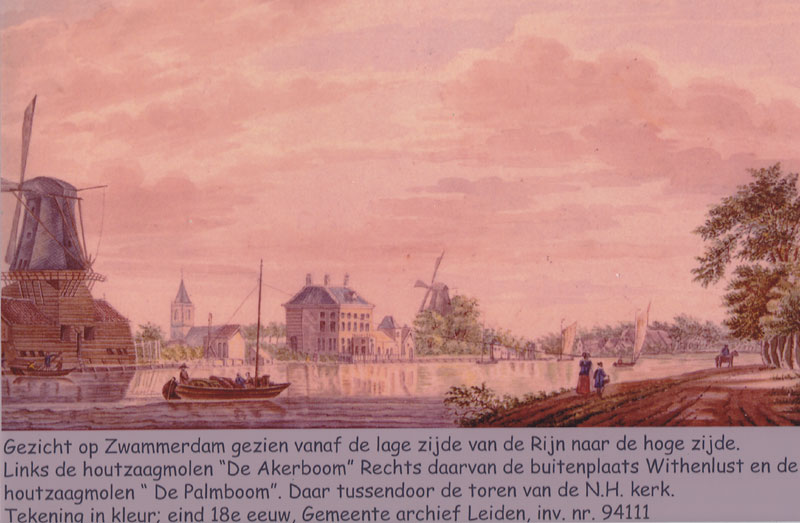
also in 1828, as before in 1820, he and his wife orderderd the collection of interest on a mortgage and/or sale of a plantation in Demerary See here..
On June 17, 1829, Jacob obtained permission from the municipal council of Alphen to build a horse-powered malt-mill at his house in the Steekterpolder (#45) near the Goudsche rijweg to start a beer brewery. He builds a house for a master servant and workers. The brewery is given the name "De Zwaan" (The Swan) a reference to the coat of arms of the village Zwammerdam.
In the same year he builds a new house called Landlust on the Straatweg in the Steekterpolder. At the 1829 census he lived there with his wife and youngest son Jean C.P.E. and 2 servants. Both gentlemen give up brewer as their profession.
At the beginning of 1830, Jacob became the executor of the estate of his aunt Barendina Eeftinck, given the death advertisements in his name. Presumably he inherits but I still have to check that.
On December 21, 1831, Jacob gave 75 guilders as payment for a replacement for conscription at the South Holland militia of his brewer's servant Leemkoel, which he may have partly withheld from his wages for safekeeping at the civil-law notary Ooijkaas.
AND THEN ! On December 24, 1831, Jacob had it officially recorded at notary public Ooijkaas that he was very opposed to the proposed marriage of his son J.C.P. Eeftinck Schattenkerk with Pieternella, daughter of Leendert Kwakernaak and that his son had known this for more than a year. That the latter subsequently threatened his father to initiate legal proceedings if paternal approval was refused. To avoid separation between father and son, he gives him permission to for God's sake marry whomever he wants.
Why his father was so opposed to his marriage is not clear. Was it a class difference, a question of religous faith, or did he had a unresolved row with father Kwakernaak, who was his neighbor on Buitendorp ?
But the fact that he actually gives his rebellious son permission to marry on the day before Christmas can also be an rather awkward gesture. His son did not appreciate it.
Meanwhile there is a lot of chatter in the village according to this advertisement.
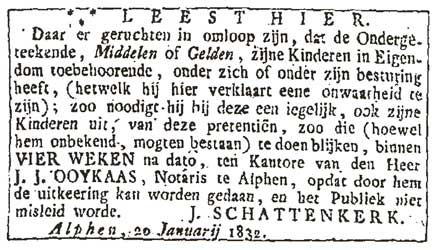
Jean solved that in his own way. The wedding took place on January 22, 1832, not in Zwammerdam but in the German town of Emmerich close to the Dutch border but outside Dutch jurisdiction. The German marriage of Jean and his Pietnella was registered on May 26 in the village of Aarlanderveen which is located near Zwammerdam.
Now Jacob is more than fed up with the situation with his disobedient son and must have felt severe loss of face in the local comunity. On May 5, 1832 he ordered notary Ooijkaas to sell a considerable part of his possessions and left Zwammerdam / Alphen and possibly Holland for good.
On offer are in the order of the deed: Article 1/15 In the Stickterpolder Landlust mansion house with coach house and shed, De Zwaan brewery with a house for the master servant and workers, approximately 28 acres of land and Catharina's Lust . Articles 16 and 17 Buitenendorp country estate with gardener's house and approximately 9 acres of land. Articles 18 and 19 in Zwammerdam Withenlust with gardener's house, garden, woodland and dome and 5 acres of land. Article 20 in Bodegraven 6 acres of pasture and cultivation land. Article 21 In Aarlanderveen builder's house Bouwlust and finally Article 22 an orchard on the old and new Kerklaan in Zwammerdam.
Sales are not going very well. In the final allocation on 22 May 1832, he sold only the garden of Withenlust (article 19) to his neighbor, Cornelis Corneliszoon Hoogendijk, and the orchard on Kerklaan (article 22) to two gentlemen De Kanter. The land register states that the house Withenlust also moved to Hoogendijk on the same date. I couldn't find that deed.
|
9 years later, Jacob moves to Praets near Emmerich Germany (Why Emmerich the place where his son married against his will ??) in the grand Reckenburg house. Did he ever see his children and grandchildren again? When he died in April 1841, he was also buried in Praets. His remains were reburied more than half a century later in 1897 by his grandson (via Charles) Jacob Volkert Schattenkerk in his Boschlag estate in Loil near Didam (now part of Montferland) Province Gelderland. See more ..
The last sign of life I could find in his notarial deeds is a sale of wood in December 1832 by notary Ooijkaas. He arranges this by letter from Prague. |
|
|
|
His wife Maria Schattenkerk-Belly returned to Zwammerdam by carriage in November 1841, accompanied by a female companion and two servants. She died in 1845.
|

Coll. CBG
|
In 1846 a division of the parental estate drawn up by notary Proosdij between the two brothers and some heirs Hoogendijk.Charles acquires Bouwlust in Aarlanderveen with land, roads etc Catharina's lust in the Steekterrpolder with land etc, Russian securities, a bond and the cash. Jean Charles Philippe Eeftinck obtains: Buitendorp estate in Zwammerdam included outbuildings land, garden etc, mansion Landlust with a watermill, a
sawmill with beam hole (= a shallow waterway, in which the stock logs from a saw-mill is preserved), shed, servants' homes, land etc in the Steekterpolder in Alphen and some parcels of land in the Vinkenbuurt extending from the Rhine to the Burgpad, including a house. In 1850 he rebuild the villa Buitenlust.The De Zwaan brewery is no longer mentioned. It has probably already been liquidated.
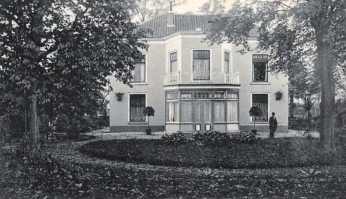 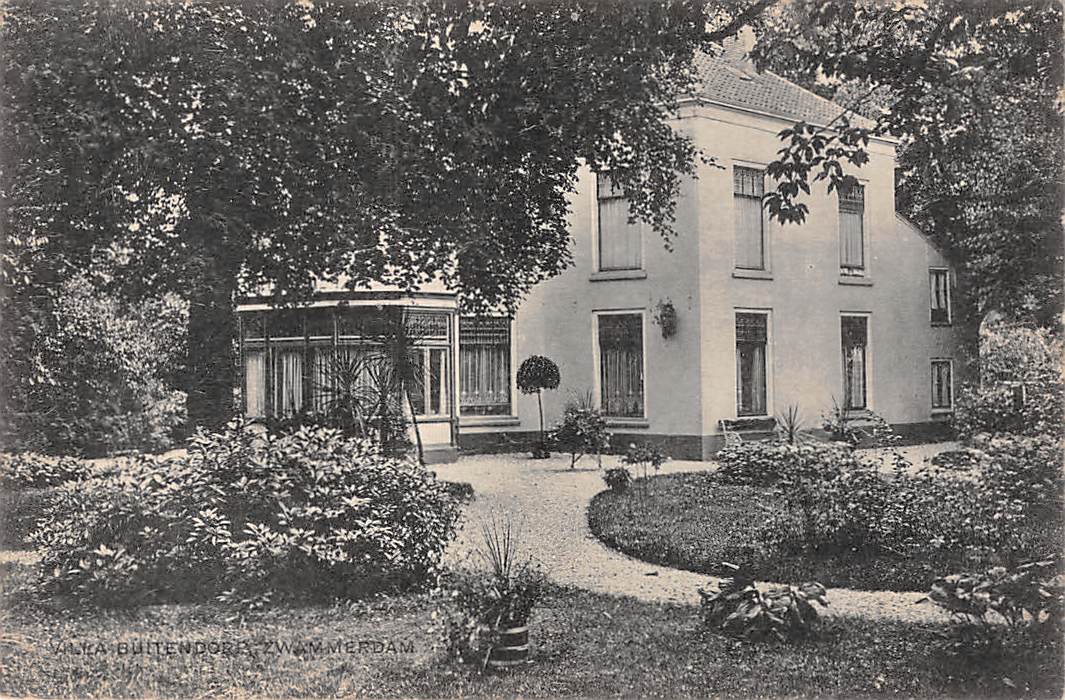 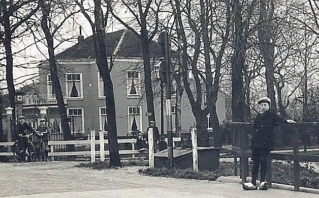
Rebuild Villa Buitenzorg
|








